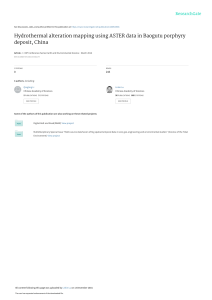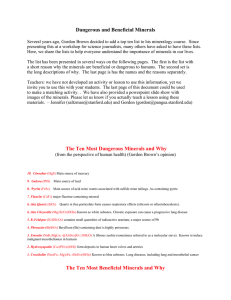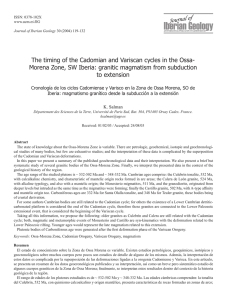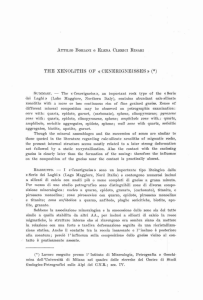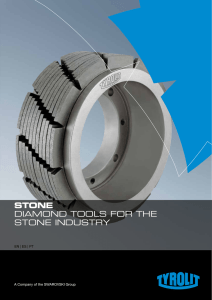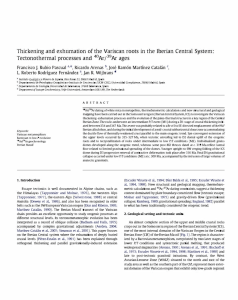Late and postmagmatic alterations in the tin
Anuncio
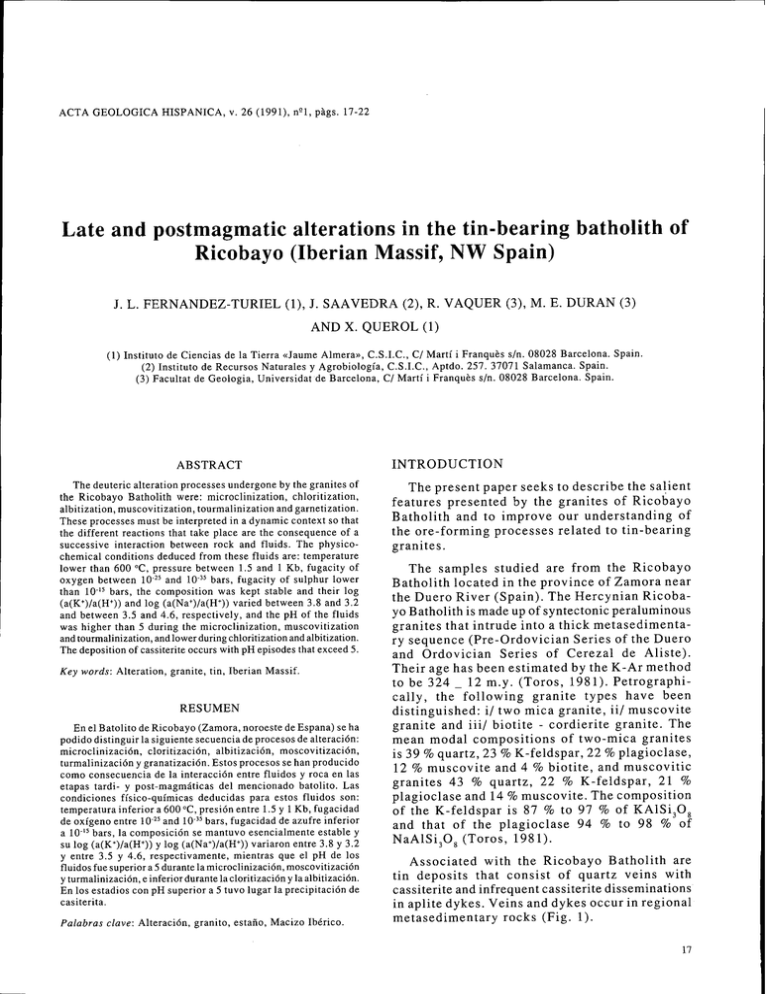
ACTA GEOLOGICA HISPANICA, v. 26 (1991), n", p8gs. 17-22 Late and postmagmatic alterations in the tin-bearing batholith of Ricobayo (Iberian Massif, NW Spain) J. L. FERNANDEZ-TURIEL (I), J. SAAVEDRA (2), R. VAQUER (3), M. E. DURAN (3) AND X. QUEROL (1) (1) Instituto de Ciencias de la Tierra jaum me Almerar, C.S.I.C., C/ Martí i Franqubs s/n. 08028 Barcelona. Spain. (2) Instituto de Recursos Naturales y Agrobiologia, C.S.I.C., Aptdo. 257. 37071 Salamanca. Spain. (3) Facultat de Geologia, Universidat de Barcelona, C/ Martí i Franques s/n. 08028 Barcelona. Spain. ABSTRACT The deuteric alteration processes undergone by the granites of the Ricobayo Batholith were: microclinization, chloritization, albitization, muscovitization, tourmalinization and garnetization. These processes must be interpreted in a dynamic context s o that the different reactions that take place are the consequence of a successive interaction between rock and fluids. The physicochemical conditions deduced from these fluids are: temperature lower than 600 OC, pressure between 1.5 and 1 Kb, fugacity of oxygen between 10-25and 10-35bars, fugacity of sulphur lower than 10-l5 bars, the composition was kept stable and their log (a(K+)/a(Ht)) and log (a(Na+)/a(H+))varied between 3.8 and 3.2 and between 3.5 and 4.6, respectively, and the pH of the fluids was higher than 5 during the microclinization, muscovitization and tourmalinization, and lower during chloritization and albitization. The deposition of cassiterite occurs with pH episodes that exceed 5. Key words: Alteration, granite, tin, Iberian Massif. RESUMEN En el Batolito de Ricobayo (Zamora, noroeste de Espana) se ha podido distinguir la siguiente secuencia de procesos de alteración: microclinización, cloritización, albitización, moscovitizaciÓn, turmalinización y granatización. Estos procesos se han producido como consecuencia de la interacción entre fluidos y roca en las etapas tardi- y post-magmáticas del mencionado batolito. Las condiciones físico-químicas deducidas para estos fluidos son: temperatura inferior a 600 OC, presión entre 1.5 y 1 Kb, fugacidad de oxigeno entre 10-25and 10-35bars, fugacidad de azufre inferior a 10-'s bars, la composición se mantuvo esencialmente estable y su log (a(K+)/a(Ht)) y log (a(Na+)/a(H+))variaron entre 3.8 y 3.2 y entre 3.5 y 4.6, respectivamente, mientras que el pH de 10s fluidos fue superior a 5 durante la microclinización, moscovitización y turmalinización, e inferior durante la cloritización y la albitización. En 10s estadios con pH superior a 5 tuvo lugar la precipitación de casiterita. P a l a b r a s clave: Alteración, granito, estaño, Macizo Ibérico. INTRODUCTION The present paper seeks to describe the salient features presented by the granites of Ricobayo Batholith and to improve our understanding of the ore-forming processes related to tin-bearing granites. The samples studied are from the Ricobayo Batholith located in the province of Zamora near the Duero River (Spain). The Hercynian Ricobayo Batholith is made up of syntectonic peraluminous granites that intrude into a thick metasedimentary sequence (Pre-Ordovician Series of the Duero and Ordovician Series of Cerezal de Aliste). Their age has been estimated by the K-Ar method to be 324 - 12 m.y. (Toros, 1981). Petrographically, the following granite types have been distinguished: i / two mica granite, ii/ muscovite granite and iii/ biotite - cordierite granite. The mean modal compositions of two-mica granites is 39 % quartz, 23 % K-feldspar, 22 % plagioclase, 1 2 % muscovite and 4 % biotite, and muscovitic granites 4 3 % quartz, 22 % K-feldspar, 21 % plagioclase and 14 % muscovite. The composition of the K-feldspar is 87 % to 97 % of KA1Si308 and that of the plagioclase 94 % to 98 % of NaA1Si308(Toros, 198 1). Associated with the Ricobayo Batholith are tin deposits that consist of quartz veins with cassiterite and infrequent cassiterite disseminations in aplite dykes. Veins and dykes occur in regional metasedimentary rocks (Fig. 1). Figure 1. Geological rnap of the studied area (1, muscovite granite; 2, two mica granite; 3, biotite - cordierite granite). Figura 1. Mapa geológico del Brea estudiada 1) granito con moscovita, 2) granito de dos micas, 3) granito con biotita y cordierita. SAMPLING AND ANALYTICAL PROCEDURES A total of 185 samples of granites s.1. from the Ricobayo Batholith were taken. The samples were studied petrographically in thin sections and chemically analysed by scanning electron microscopy with an energy dispersive X-ray microanalysis system (SEM-EDS). For whole rock chemistry, SiO, and P,O, were determined by colorimetry, total Fe as Fe20,, Na20, K,O, C a 0 and MgO by atomic absorption spectrometry and Rb, Ba, Sr, Zr, Sn, W and TiO, by X-ray fluorescence spectrometry. Analytical methods are described in Garcia and Saavedra (1983). K-feldspar, very locally from plagioclase and, apparently, the secondary microcline is not affected; it occurs in irregular patches and perthites with irregular edges and more o less vague polysynthetic twinning. The intergranular albite is located in the K-feldspar K-feldspar interphase and is less frequent in plagioclase - K-feldspar interphase, sometimes penetrating the adjacent mineral phases. The albite is present as sub-automorphous twinned crystals according to the laws of albite and Carlsbad and xenomorphous crystals without twinning, with polysynthetic twinning or with myrmekites. They occur in isolation or in groups giving textures resembling a chessboard. Muscovitization has produced the most striking modifications in the granites studied giving rise to a considerable development of both replacement muscovite (from biotite and primary feldspars and, to a lesser degree, to microcline and secondary albite) and intergranular muscovite. SEM-EDS data have not indicated the existence of paragonite; these are in agreement with the microprobe analyses of Pierrel (1984) which indicate contents of 0.23 to 0.97 % Na,O. Tourmalinization. Two petrographic types of tourmaline (schorlite) are observed: green bluish tourmaline and a brown tourmaline. Crystals with a gradual transition of colours between the two end-members as well as zoned crystals can also be seen. In the zoned crystals the green bluish colours appear in the centre of the crystals and the darker browns appear towards the edges. The most significant chemical variations between the tourmalines of both colours based in SEM-EDS data are the Mg, Ti and K contents which increase towards the brownish parts of the crystals while Mn diminish. Garnetization. Petrographically, it has been observed that when garnet (almandine) appears, which is EFFECTS ON THE MINERALOGY The petrographic study of the samples shows the existence of replacement phenomena of primary minerals (magmatic) by secondary minerals and the genesis of new minerals in relation to the processes of deuteric alteration: Microclinization. Plagioclase and primary K-feldspar are replaced by microcline that shows the cross-hatched twinning (albite and pericline laws) usually well defined. Chloritization. Replacement of biotite by chlorite and rutile (generally acicular, see Fig. 2) and, to a much more limited degree, by chlorite and K-feldspar. Albitization. Replacement albite and intergranular albite with different petrographic textures are produced. The replacement albite is developed from Figure 2. Aciculnr r u t ~ l ein c h l o r ~ t el'rom biotite tranaformalion according to reaction (6) of Table 1. Figura 2. Rutilo acicular en clorita proveniente de alteración de la biotita por la reacción ( 6 ) de la Tabla 1. very rare, tourmaline is always found in the sample and sometimes in close relationship with garnet; green bluish tourmaline crystals are included within garnets (Fig. 3). Crystallization of garnet in relation to tourmaline may occur by an enrichment of Mn in the fluids (for high Fe/(Fe+Mg) compositions). The superposition relationships of the deuteric processes enable us to define the following time sequence: microclinization, chloritization, albitization, muscovitization, tourmalinization and garnetization stages. This sequence is similar to one observed by Pollard and Taylor (1986) for the granites related to tin mineralization in the Herberton tin field in Australia. EFFECTS ON THE WHOLE ROCK CHEMISTRY The concentrations of the major oxides and the trace elements with the most significant variations as regards the alteration processes are plotted versus Zr (Figs. 4 and 5) because this is the element thought to be the most immobile among those studied. The use of other immobile elements such as Ti or Al or ratios between them (eg. Al/Ti, cf. eg. Vaquer and Adell, 1987) was not possible because the Ti concentrations are, in general, below the analytical detection threshold (< 0.10 % TiO,). Figures 4 and 5 show diverging trends in relation to the general magmatic trends: SiO, concentrations decrease, Na,O and Sr increase, A1,0,, Fe,O, and Rb are dispersed and K 2 0 shows no substantial variation. As regards the deuteric processes it is possible to explain the increase in Na and Sr by the albitization process whereas the apparent stability of K and the dispersion of Al, Fe and Rb are due to the relative . A 77 74 - 71 - -8. so 'o" @;8.O 0 0 A.o.,qB. S i O2 . O $+ ,. .... . . . ..*. .: .p l O*w-. !,re *go' O . .OP O =o . 68 I I 19 - I I I I . . l 1 - A 10 - . I -0 O I 1 I I I I I I I 7- NapO 2 - 9. I 6 i . I I -- 1 . O I *. . 2 2- . . I I I I C a 0 l- 0.51 $%&:F FB! m 20 * i Zr 1 140 Figure 4. Contents of SiO,, A1,0,, Na,O, K,O and C a 0 plotted versus Zr. Closed circles, two mica granite; open circles, muscovite granite; closed triangles, aplite hosted in granite; open triangles, aplite hosted in metasedimentary regional rocks. Figure 3. Green bluish tourmaline (T) in garnet (G). Figura 3. Turmalina verde-azulada (T) en granate (G). Figura 4. Contenidos en SiO,, A1,0,, Na,O, K,O y C a 0 en ord e n a d a ~y Zr en abcisas. Círculos llenos: granito de dos micas; círculos vacíos: granito con moscovita; triángulos llenos: aplita encajante en granito; triángulos vacios: aplita encajada en rocas meta-sedimentarias. 19 interaction of the alteration processes considered. The trend towards low values of Fe and high values of Rb in some samples is associated with the muscovitization. The loss of silica cannot be explained solely by the alteration processes considered in the previous sections and must be related to dissolution phenomena of quartz which are frequently associated with Na and/or K metasomatism (Cathelineau, 1986). The petrographic evidence of this dissolution is difficult to detect due to the degree of deformation of the studied rocks (it should be remembered that they are syntectonic granites). Thus, it is not easy to place the phenomenon on the time scale. PHYSICO-CHEMICAL CONDITIONS OF THE ALTERATION The study of the Ricobayo Batholith (Fernandez Turiel, 1987), especially when bearing in mind its mineral paragenesis suggests that its petrogenetic evolution has taken place in two stages: the first stage characterized by a sharp fall in the pressure with a slight decrease in temperature (P-T conditions of >7 to 2 Kb and >700 to 650 C) which result in the rise of the magma, and the second stage characterized by a O 1 2 3 4 5 6 Log ( a ( ~ + ) l a ( H + ) ) Figure 5. Contents of Fe203,Rb and S r plotted versus Zr. Syrnbols as for Fig. 4. Figura 5. Contenidos en Fe20,, Rb y S r contra Zr. Simbologia igual que en la Fig. 4. Figure 6. Evolution trend of alteration fluids in the system HCl - H 2 0 - (A1203)- K 2 0 - Na,O - SiO,, in equilibriurn with quartz at 1 Kb (P = PH,,), based on Bowers et al. (1984). Figura 6. Evolución de 10s fluidos de alteración en el sistema HCl - H 2 0 - (A1,0,) - K 2 0 - N a 2 0 - SiO,, en equilibri0 con cuarzo a 1 Kb (P = P,,,), basado en Bowers et al. (1984). sharp decrease in temperature (< 600 C) and a pressure that trends to stabilize between 1 and 1.5 Kb which represents the evolution of the granites once emplaced. These pressure conditions are supported by the coexistence of andalucite and hercinite and the absence of associated volcanic and subvolcanic manifestations (Fernandez Turiel, op. cit.). It is in this second stage that the deuteric processes of alteration take place. Microclinization albite + K+ -> anorthite + Na+ (1) + 4 SiO, + 2 K+ -> + Ca2+(2) 2 microcline Chloritization 6 biotite These data and the possible reactions associated with the alteration processes (Table I) allow us to take as reference the system HC1- H 2 0- (A120,) - K 2 0 - Na,O - SiO,, in equilibrium with quartz at 1 Kb (P = P,,,,) based on Bowers et al. (1984) in order to improve our understanding of the composition evolution of the fluids that caused the alterations (Fig. 6). These diagrams suggest that the modifications observed may be especially explained by the temperature change. The changes in the composition that are necessary to account for these modifications are relatively small. The values of K and Na activities, expressed as log (a(K+)/a(H+))and log (a(Na+)/a(H+)), would vary between 3.8 and 3.2 and between 3.5 and 4.6, respectively. microcline + 12 H+ -> 3 chlorite + 3 Fe2++ 9 SiO, + 6 K++ 12 H,O (3) biotite + H 2 0 -> chlorite + K-feldspar biotite + H,O -> chlorite biotite + H,O -> + TiO, (4) + K-feldspar (5) chlorite + TiO, + K+ (6) Albitization K-feldspar anorthite + Na+ -> albite + K+ (7) + 4 SiO, + 2 Na+ -> 2 albite + Ca2+(8) Muscovitization + 20 H+-> + 2 K'+ Mg2++ Fe2++ 24 H,O muscovite + 6 SiO, + 2 Kt (10) Additional information concerning the physico chemical conditions during the alteration processes may be obtained from the tin mineralizations associated with the alteration processes studied in this work. In this sense, the cassiterite quartz veins present three paragenesis (Fernandez-Turiel, 1987): 1) cassiterite - K-feldspar - quartz, 2) cassiterite - muscovite - quartz and 3) cassiterite - tourmaline - quartz; in the last two cases there are also arsenopyrite, pyrite and chalcopyrite which are always later than the cassiterite genesis. These three paragenesis can be associated with the microclinization, muscovitization and tourmalinization stages of alteration in the granites, respectively. The presence of cassiterite suggest, under the conditions studied here, the existence of a pH exceeding 5 during the microclinization, muscovitization and tourmalinization stages (Jackson and Helgeson, 1985). biotite Moreover, the lack of sulfides in the altered granites and in the general paragenesis of associated tin mineralizations allow us to deduce some values of sulfur fugacity during the alterations not exceeding l O - I 5 bar, which is consistent with the oxygen fugacities deduced in general for tin deposits (between 1025 and 10-35 bars), see eg. Dubessy et al. (1987). REFERENCES In synthesis, the alterations shown by the granites of the tin-bearing Ricobayo Batholith have been produced by fluids of essentially similar composition that evolved in a dynamic context where different physico-chemical parameters interact. The most decissive of these where the drop in the temperature and the fluctuation of the PH. CHAYES, F. 1955: Potash feldspar as a by-product of the biotitechlorite transformation. J. Geol., 63: 75 -82. muscovite + 2 H+ -> 3 albite + K+ + 2 H+-> 3 K-feldspar 3 anorthite muscovite + 2 Kt + 4 H+ -> (9) + 6 SiO, + 3 Na+ (11) 2 muscovite + 3 Ca2*(12) Table 1. Proposed reactions for the replacement phenomena of deuteric alterations in the Ricobayo Batholith granites. Reaction (3) after Cathelineau et a1 (1986), (4) after Monier et al. (19841, after Chayes (1955), (9) to (12) after Cathelineau et al. (op. cit.) and Hemley and Jones (1964). Table 1. Reacciones propuestas para 10s fendmenos de alteracianes deutéricas en 10s granitos del batolito de Ricobayo. ReacciBn (3) de Cathelineau et al. (1986); (4) de Monier et al. (1984); de Chayes (1955); (9) a (12) de Cathelineau et al. (1986) y Hemley y Jones (1964). BOWERS, T.S., JACKSON, K.J. and HELGESON, H.C.1984: Equilibriumactivity diagrams. Springer Verlag, Berlin-Heidelberg, 397 pp. CATHELINEAU, M. 1986: The hydrothermal alkali metasomatism. Effects on Granitic rocks: Quartz dissolution and related subsolidus changes. J. Petrol., 27,45-965. DUBESSY, J., RAMBOZ, C., NGUYEN-TRUNG, C., CATHELINEAU, M., CHAROY, B., CUNEY, M., LEROY, J., POTY, B. and WEISBROD, A. 1987: Physical and chemical controls (fO , T, pH) of the opposite behaviour of U and Sn-W as exemplified by hydrothermal deposits in France and Great Britain, and solubility data. Bull. Minéral., 110, 261 - 281. FERNANDEZ TURIEL, J.L. 1987: Aspectos geologicos y metalogeneticos del Batolito de Ricobayo y Complejo de VillasecoPereruela y sus mineralizaciones estannijerasasociadas (Zamora). Ph. D. Thesis, Univ. of Barcelona, 307 pp. GARCIA, A. and SAAVEDRA, J. 1983: Datos analíticos sobre cuatro patrones geoquimicos de Salamanca (granitos s.1.) y técnicas utilizadas. An. CEBAS-IOATO, 9, 331-333. HEMLEY, J.J., and JONES, W.R., 1964: Chemical aspects of hydrothermal alteration with emphasis on hydrogen methasomatism. Econ. Geol., 59, 538-564. JACKSON, K.J., and HELGESON, H.C. 1985: Chemical and thermodynamic constraints on the hydrothermal transport and depsosition of tin: I. Calculation of the solubility of cassiterite at high pressures and temperatures. Geochim. Cosmochim. Acta, 49, 1 - 22. MONIER, G., MERGOIL-DANIEL, J. and LABERNARDIERE, H. 1984: Générations successives de muscovites et feldspaths potassiques dans les leucogranites du massif de Millevaches (Massif Central francais). Bull. Minéral., 107, 55-68. PIERREL, L. 1984: Gisements Sn - W dans des superstructures de métamorphites sur le trace de linéaments leucogranitiques hercyniens: Mina La Sultana (Galice)et Mina Dorinda (Zamora), en Espagne. 38me Cycle Thesis, Univ. of Nancy 1,247 pp. POLLARD, P.J. and TAYLOR, R.G. 1986: Progressive evolution of alteration and tin mineralization: controls by intertitial permeability and fracture-related tapping of magmatic fluid reservoirs in tin granites. Econ. Geol., 81, 1795 - 1800. TOROS, M. 1981: Les granitoides et les gites d'étain associés dans leur contexte lithostratigraphique et métamorphique ci I'Ouest de Zamora (Massif,Hespérique, Espagne). Thesis, Univ. of Lausanne, 216 pp. VAQUER, R. and ADELL, A. 1987: Evolución geoquímica de las bandas miloniticas de la Granodiorita de Roses (Pirineos Orientales). In A. M. Neiva et al. eds. Abstracts of I Reuniao Ibérica de Geoquímica, 1.A.
